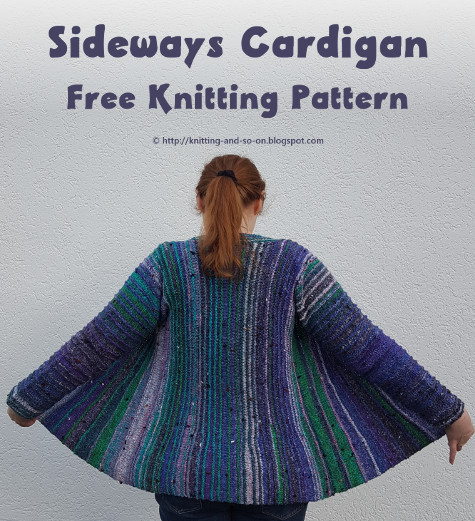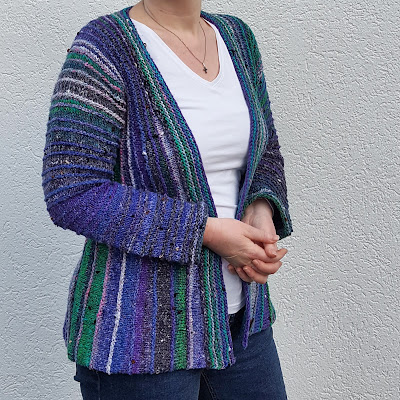You now have to calculate the increases you have to do in order to reach B stitches at the shoulder.
I wanted to reach 72 stitches at the shoulder, i.e. I had to increase by 13 ((72-46)/2 = 26/2 = 13) on each side (beginning and end of row) - and I had 128 rows to reach that (D=136 rows, minus 8 rows already knitted for the "instead-of-ribbing"). So I decided had to do increases every 10th row (i.e. that would give 130 rows, but this difference (1cm) was OK for me).
Start knitting the stitch pattern above and increase (as calculated at the beginning and end of the rows)
As calculated I knitted the pattern and increased at the beginning and end of every 10th row, i.e. after 130 I had 13x2 = 26 sts more than the CO, i.e. 46+26 = 72 sts.
To help me count the rows of the body part and to measure, I marked the last row of the sleeve with a removable stitch marker.
Body (Back Piece and Two Front Pieces)
Left Half
Knit the next row, at the end of the row, with a knitted cast-on, CO D stitches for the front.
Then turn, knit back and CO D stitches for the back.
I wanted to add 39 cm to the lenght (added to the sleeve width - back and front), so I CO'd 72 sts on each side.
Since you're knitting sideways and the shoulders are narrower than the piece around the hips, you now have to calculate the amount of short rows to knit at the front and the back. Plus, you have to decide where you want your short rows to end.
The short rows for the front piece are calculated by the ratio of G to I (i.e. shoulder width to width at the hip of one half).
And the short rows for the back piece by the ratio of G+H to J/2 (i.e. shoulder width plus half of the neckline width to half of the width at the hip.
This means, that you have more short rows on the front than on the back.
For the front I had G = 10 cm and I=25 cm, i.e. for each shoulder ridge, I had to knit 2,5 ridges on the lower edge, i.e. a ratio of 1:2,5 or 2:5.
For the back it was G+H=10+10= 20 cm and J/2 = 50/2 = 25 cm. So I had the ratio of 2:2,5 or 4:5.
I wanted to keep the pattern of 1 garter ridge and stockinette rows inbetween.
So, taking into account the short rows calculated above, I ended up with this pattern, but I varied the points where I did the w+t's a bit.
Row 1 (RS, S2): sl1, k to end
Row 2 (WS, S2): sl1, k to end // garter stitch ridge
Row 3 (RS), S1): sl1, k to end
Row 4 (WS, S1): sl1, p65, w+t
Row 5 (RS, S1): k to end
Row 6 (WS, S1): sl1, p40, w+t
Row 7 (RS, S1): k to end
Row 8 (WS, S1): sl1, p15, w+t
Row 9 (RS, S1): k to end
Row 10 (WS, S1): sl1, p to end // stockinette part with short rows in front
Repeat rows 1 to 10 once, after you've the last row for the 2nd time, continue with
Row 21 (RS, S1): sl1, k35, w+t
Row 22 (WS, S1): p to end // stockinette part plus short rows in the back
I knitted these rows 4 times, i.e. until the shoulder was wide enough.
Knit the calculated pattern until you've reach the shoulder width.
Now you have to BO the stitches on the front part, i.e. knit to the end of an RS row and BO C stitches.
In my case I had to BO 108 sts. So I knitted an RS row, and started the WS with binding off 108 sts.
Now that you've reached the neck of the piece and have done a BO of the front stitches, you need to knit only the part of the rows, that is on the back of the cardigan.
For me that meant skipping the rows that were called row 4 to row 9 in the body pattern above, i.e. the following:
Row 1 (RS, S2): sl1, k to end
Row 2 (WS, S2): sl1, k to end // garter stitch ridge
Row 3 (RS), S1): sl1, k to end
Row 4 (WS, S1): sl1, p to end // stockinette rows
Repeat rows 1 to 4 once more. After you've the last row for the 2nd time, continue with
Row 9 (RS, S1): sl1, k35, w+t
Row 10 (WS, S1): p to end // stockinette part plus short rows in the back
However, if you want to have a slight curve in the back of the neckline, you have to do some decreases at the end of the first RS rows to shape a curve in your neck.
I wanted a curve that was 1,5 cm deep, so over the first 6 rows, I decreased one stitch every other row, i.e. I knitted up to the last three stitches of a RS row and ended with "ssk, k1".
Knit your calculated pattern until you've reached exactly the centerline of your piece.
I ended on a stockinette row in S2. For a nice symmetry (and to stay "in pattern") I knitted one garter stitch ridge in S1.
Right Half
After reaching the middle of your piece, you basically have to knit a mirror image of the 1st half, i.e.
- you increase where you decreased before,
- you to a BO where you did a CO before (and vice versa),
- you knit the same short rows as before - just in reverse order.
So first you knit the back part only.
For me this meant the following for rows 1 to 10 of the back-only part.
Row 1 (RS, S1): sl1, k to end
Row 2 (WS, S1):, p to end
Row 3 (RS, S1): sl1, k35, w+t
Row 4 (RS, S1): p to end // stockinette part plus short rows in the back
Row 5 (RS, S2): sl1, k to end
Row 6 (WS, S2): sl1, k to end // garter stitch ridge
Row 7 (RS, S1): sl1, k to end
Row 8 (WS, S1): sl1, p to end // stockinette rows
Row 9 (RS, S2): sl1, k to end
Row 10 (WS, S2): sl1, k to end // garter stitch ridge
Plus, just before you finish the back-only part, you need to include some increases at the upper edge (to mirror the decreases you did during the right half.
For me that meant that - starting from the 6th row before I had to do the BO, I increased one stitch every other row, i.e. I knitted up to the last two stitches of a RS row and ended with "kfb, k1".
Then you need to CO the front stitches again, i.e. knit an RS row and then do a knitted CO of the calculated number of stitches.
I knitted an RS row, then continued by casting on 108 stitches
Knit the same pattern you knitted for the left half in reverse order until you've reached the shoulder width.
For me that meant knitting the following sequence
Row 1 (RS, S1): k to end
Row 2 (WS, S1): sl1, p15, w+t
Row 3 (RS, S1): k to end
Row 4 (WS, S1): sl1, p40, w+t
Row 5 (RS, S1): k to end
Row 6 (WS, S1): sl1, p65, w+t
Row 7 (RS, S1): k to end
Row 8 (WS, S1): sl1, p to end
Row 9 (RS, S1): sl1, k35, w+t
Row 10 (WS, S1): p to end // stockinette "ridge" with short rows front and back
Row 11 (RS, S2): sl1, k to end
Row 12 (WS, S2): sl1, k to end // garter ridge
Row 13 (RS, S1): k to end
Row 14 (WS, S1): sl1, p15, w+t
Row 15 (RS, S1): k to end
Row 16 (WS, S1): sl1, p40, w+t
Row 17 (RS, S1): k to end
Row 18 (WS, S1): sl1, p65, w+t
Row 19 (RS, S1): k to end
Row 20 (WS, S1): sl1, p to end // stockinette "ridge" with short rows only in front
Row 21 (RS, S2): sl1, k to end
Row 22 (WS, S2): sl1, k to end // garter ridge
Once you've reached the shoulder width of the right shoulder, knit to the end of the row, turn and BO D stitches (front), and knit to end. Then BO D stitches (back). The number of stitches that you have left now should be exactly the number you had when you finished the first sleeve.
For me that meant:
Row 1: sl1, k to end
Row 2: BO72, k to end
Row 3: BO72
Right Sleeve
The right sleeve is the left sleeve knitted backwards, i.e. knitting the stitch pattern in reverse order and doing decreases where you did increases before.
Knit in pattern (with the decreases) until your right sleeve has the same length than the left.
I knitted the sleeve stitch pattern in reverse order ...
Row 1 (RS), S2): sl1, k to end
Row 2 (WS, S2): sl1, k to end // garter ridge
Row 3 (RS, S1): sl1, k to end
Row 4 (WS, S1): sl1, p to end
Row 5 (RS, S1): sl1, k to end
Row 6 (WS, S1): sl1, p to end // stockinette part
Row 7 (RS), S2): sl1, k to end
Row 8 (WS, S2): sl1, k to end // garter ridge
Row 9 (RS, S1): sl1, k to end
Row 10 (WS, S1): sl1, p to end // stockinette part
... while I did decreases at the beginning and end of every 10th row.
Then finish with the same "ribbing" you did on your left sleeve and bind off (loosely).
In my case that meant knitting 4 ridges of garter stitch alternating the skeins.
Collar
Pick up stitches all along the inner edge on the left front, the neck and the right edge in front (see green line in figure 1 above).
Knit (back and forth) 3 ridges of garter stitch.
Calculate the size of your button holes and decide where you want to put the buttons, i.e. decide on the distance between two buttons and calculate the appropriate number of stitches.
Knit up to the 1st button hole, BO the number of stitches for 1 button, k to the next button hole, BO the number of stitches for 1 button
The buttons I bought had a diameter of 2,5cm, so I decided that I'd make my button holes 4 sts wide and I decided that I'd place them within the lowest 20 cm, i.e 40 sts,
So I knitted the "botton hole ridge" as follows:
sl1, k7, BO4, k10, BO4, k10 BO4, k to end;
sl1, k up to first BO, CO4, k10, CO4, k10, CO4, k to end
Knit 3 more ridges of garter stitch, BO during the last row.
Finishing
I prefer to block the finished piece (sewn up) rather than the flattened out version. Both methods have their advantages and disadvantages.
Sew the side underarm seams together and the buttons on. Weave in ends.
Sew on buttons and block the piece.





























